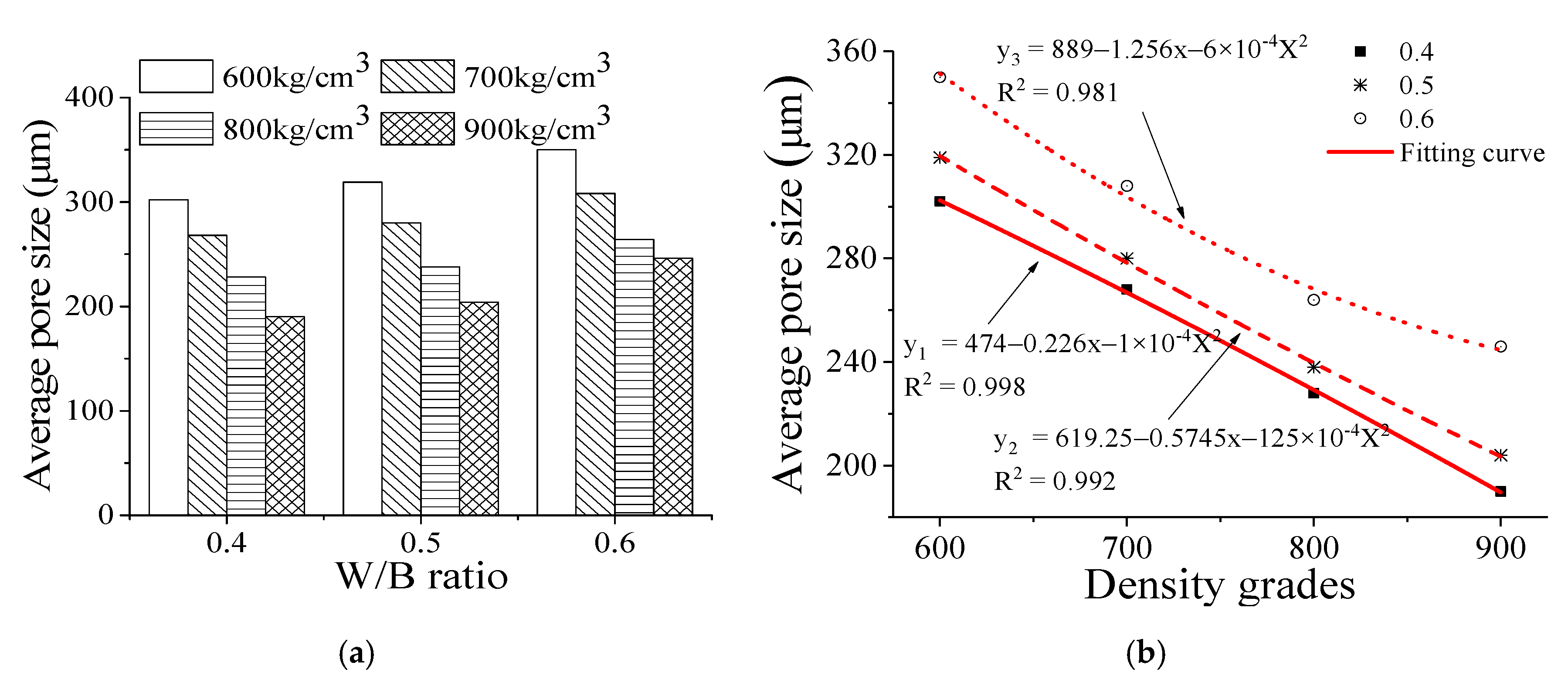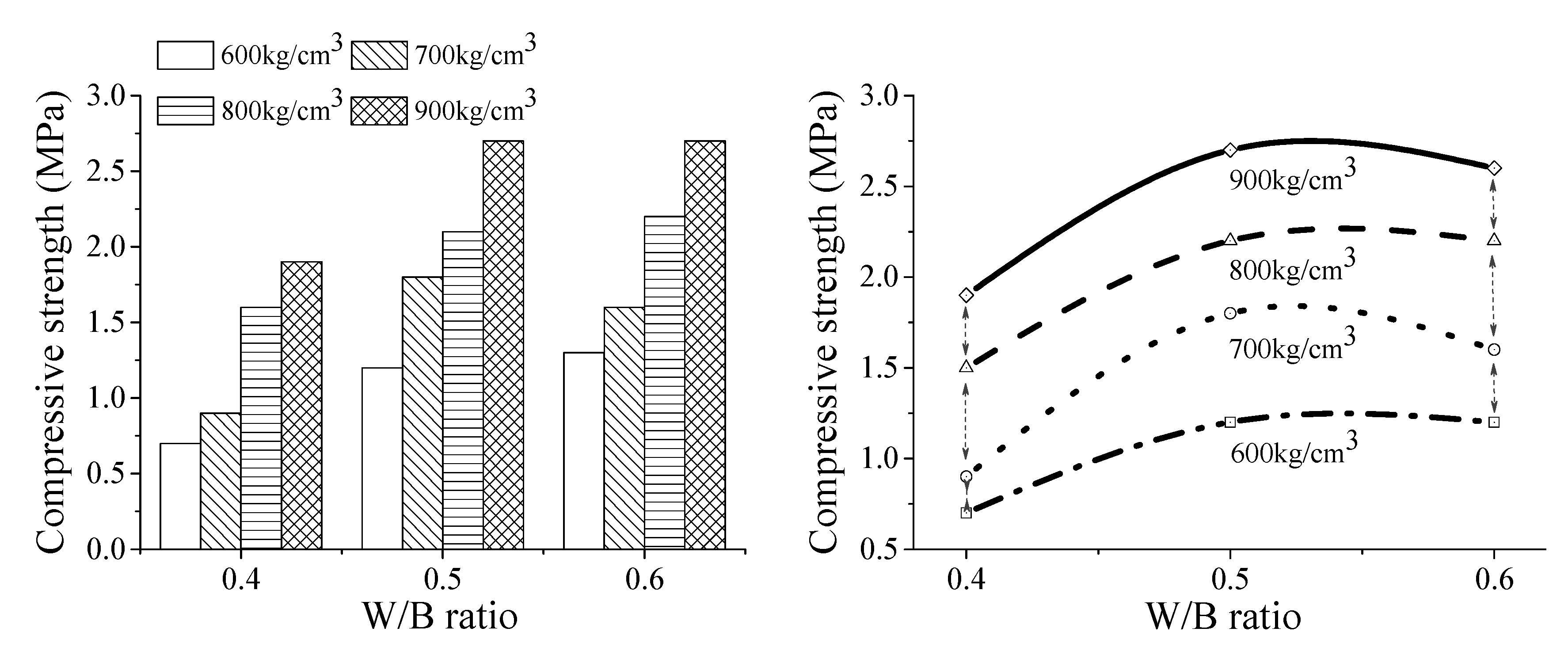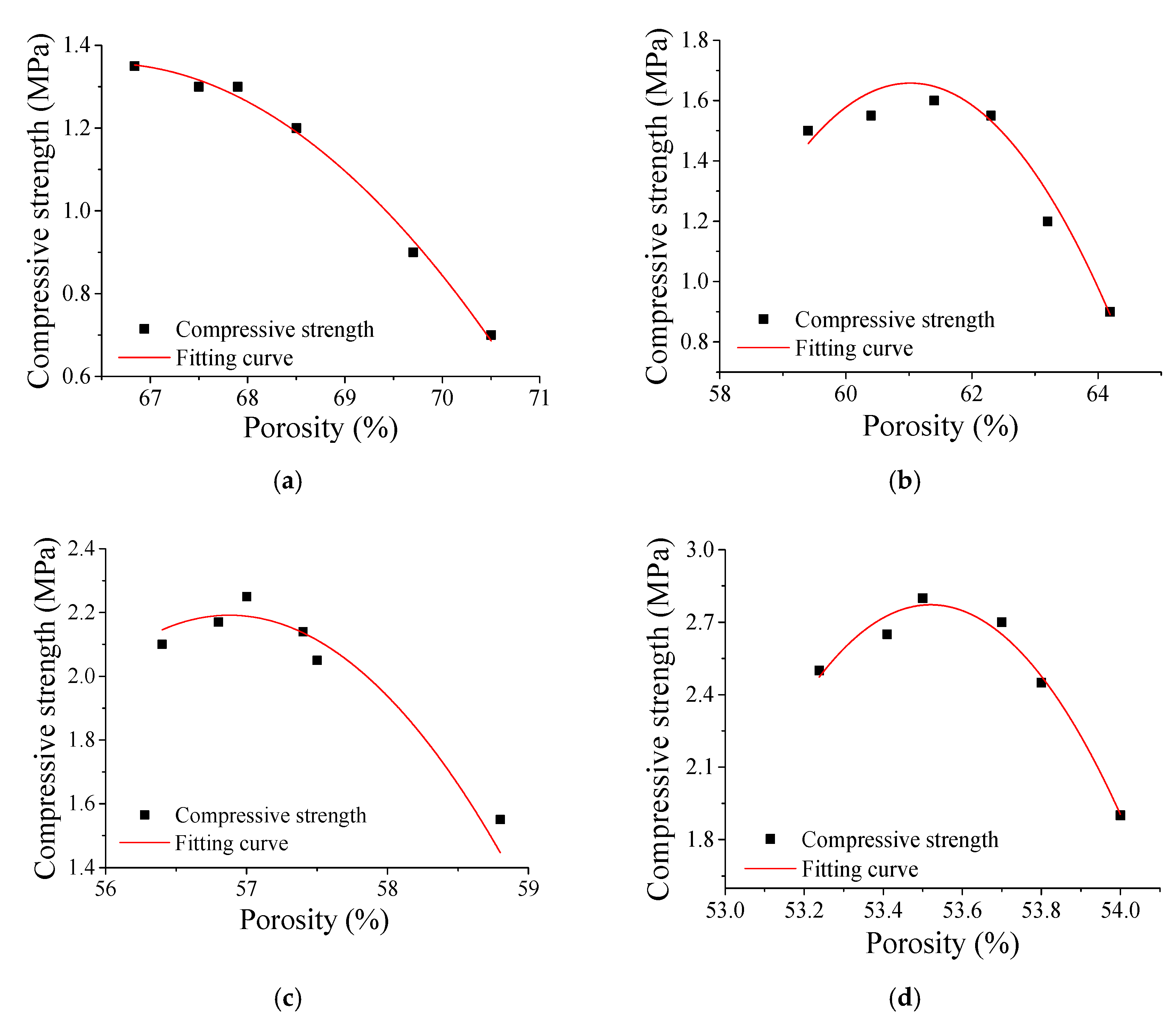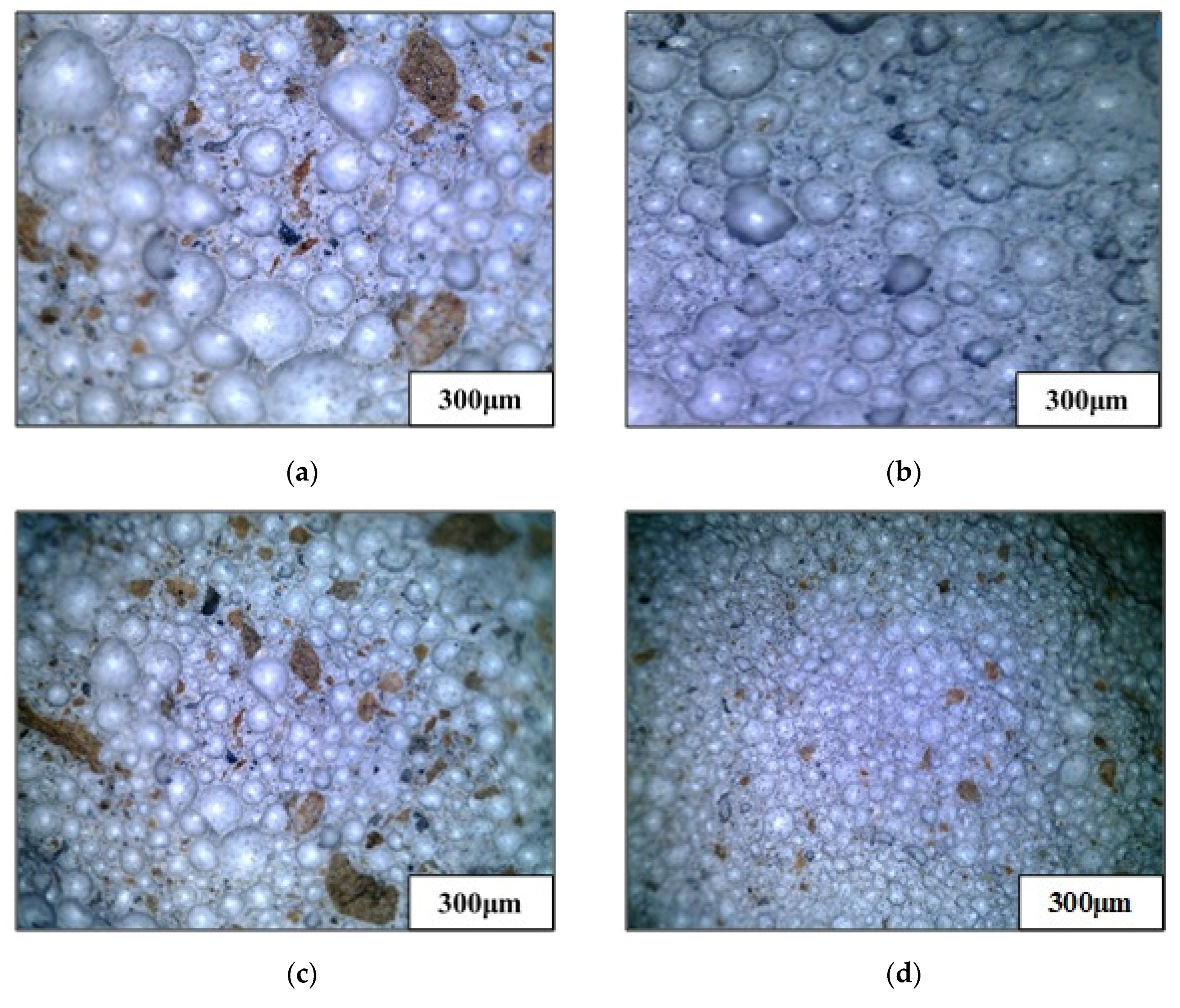Pore Structure, Morphology, and Strength of Self-Compacting Foam Material Backfilled Behind the Underground Pipe-Wall of Yellow River
Abstract
:1. Introduction
2. Experiment Materials and Methods
2.1. Experiment Materials
2.2. Foam Backfill Material Preparation Procedures
2.2.1. Preparation of Foam
2.2.2. Preparation of Foam Backfill Material
2.3. Test Methods and Mix Ratios of Foam Backfill Material
2.3.1. Dry Density of Backfill Foam Materials
2.3.2. Compressive Strength of Foam Backfill Materials
3. Results and Discussion
3.1. Average Pores Size and Porosity of the Foam Backfill Material
3.2. The Compressive Strength of the Foam Backfill Material
3.3. Morphologies of the Foam Backfill Material with Different Density
4. Conclusions
- (a)
- The average pore size of the foam backfill material with different density is increased with the increase of the water–cement ratio. The increments in the average size of the pores in the foam backfill material with increasing the water–binder ratio from 0.40 to 0.50 are larger than that of the samples with increasing the water–binder ratio from 0.50 to 0.60.
- (b)
- At a lower water–binder ratio, the average size pores of the foam backfill materials and their porosity are decreased with the increase of density. On the contrary, at a higher water–binder ratio, most of the average size pores of the foam backfill material are decreased with increasing the density from 600 to 900.
- (c)
- At a fixed water–binder ratio, the compressive strength of the foam backfill material increases with increasing the density. At a fixed density, the compressive strength of the foam backfill material first increases and then decreases with increasing the water–binder ratio. When the water–binder ratio is above 0.4, the compressive strengths of backfill materials with a density of 800 kg/m3 and 900 kg/m3 are higher than 2 MPa, which meets the strength requirements of backfill materials used for construction of the underground pipe wall of Yellow River dike.
- (d)
- Increasing the density leads to a decrease in the diameter of air bubbles. Further analysis finds that the pore structures and the strengths of the foam backfill materials are closely related.
Author Contributions
Funding
Conflicts of Interest
References
- Hilal, A.A.; Thom, N.H.; Dawson, A.R. On void structure and strength of foamed concrete made without/with additives. Constr. Build. Mater. 2015, 85, 157–164. [Google Scholar] [CrossRef]
- Nambiar, E.; Ramamurthy, K. Air-void characterization of foamed concrete. Cem. Concr. Res. 2007, 37, 221–230. [Google Scholar] [CrossRef]
- Sun, Y.; Gao, P.; Geng, F.; Li, H.; Zhang, L.; Liu, H. Thermal conductivity and mechanical properties of porous concrete materials. Mater. Lett. 2017, 209, 349–352. [Google Scholar] [CrossRef]
- Wee, T.-H.; Daneti, S.B.; Tamilselvan, T. Effect of w/c ratio on air-void system of foamed concrete and their influence on mechanical properties. Mag. Concr. Res. 2011, 63, 583–595. [Google Scholar] [CrossRef]
- Mydin, A.O.; Wang, Y.C. Thermal and mechanical properties of lightweight foamed concrete at elevated temperatures. Mag. Concr. Res. 2012, 64, 213–224. [Google Scholar] [CrossRef]
- Gao, P.; Lu, X.; Yang, C.; Li, X.; Shi, N.; Jin, S. Microstructure and pore structure of concrete mixed with superfine phosphorous slag and superplasticizer. Constr. Build. Mater. 2008, 22, 837–840. [Google Scholar] [CrossRef]
- Liang, X.; Chen, G.X. Application status of cast in place foamed concrete. Build. Energy Effic. 2017, 45, 122–128. [Google Scholar]
- Just, A.; Middendorf, B. Microstructure of high-strength foam concrete. Mater. Charact. 2009, 60, 741–748. [Google Scholar] [CrossRef]
- Hilal, A.A.; Thom, N.H.; Dawson, A.R. On entrained pore size distribution of foamed concrete. Constr. Build. Mater. 2015, 75, 227–233. [Google Scholar] [CrossRef]
- Amran, Y.M.; Farzadnia, N.; Ali, A.A.A. Properties and applications of foamed concrete; a review. Constr. Build. Mater. 2015, 101, 990–1005. [Google Scholar] [CrossRef]
- Zhao, G.; Jiang, X.; Zhang, Y. Seismic performance analysis of lightweight concrete long-span continuous rigid frame. In Proceedings of the 18th National Bridge Academic Conference, Copenhagen, Denmark, 7–8 November 2019. [Google Scholar]
- Ye, Y.; Li, L.; Sun, W. Experimental study on the seismic performance of internally injected foam concrete hollow block walls. Earthq. Eng. Eng. Vib. 2004, 24, 154–158. [Google Scholar]
- Yang, K.-H.; Lee, K.-H. Tests on alkali-activated slag foamed concrete with various water-binder ratios and substitution levels of fly ash. J. Build. Constr. Plan. Res. 2013, 1, 8–14. [Google Scholar] [CrossRef]
- Zhang, Z.; Provis, J.L.; Reid, A.; Wang, H. Mechanical, thermal insulation, thermal resistance and acoustic absorption properties of geopolymer foam concrete. Cem. Concr. Compos. 2015, 62, 97–105. [Google Scholar] [CrossRef]
- Tikalsky, P.J.; Pospisil, J.; Macdonald, W. A method for assessment of the freeze–thaw resistance of preformed foam cellular concrete. Cem. Concr. Res. 2004, 34, 889–893. [Google Scholar] [CrossRef]
- Liu, Z.; Zhao, K.; Hu, C.; Tang, Y. Effect of Water-Cement Ratio on Pore Structure and Strength of Foam Concrete. Adv. Mater. Sci. Eng. 2016, 2016, 1–9. [Google Scholar] [CrossRef] [Green Version]
- Sang, G.; Zhu, Y.; Yang, G. Influence of water-cement ratio on property of light weight cement based foam material. J. Mater. Sci. Eng. 2015, 3, 339–342. [Google Scholar]
- Jones, M.R.; McCarthy, A. Utilising unprocessed low-lime coal fly ash in foamed concrete. Fuel 2005, 84, 1398–1409. [Google Scholar] [CrossRef]
- Common Portland Cement; GB175-2007; National Standard of the People’s Republic of China: Beijing, China, 2007.
- Fly Ash Used for Cement and Concrete; GB/T1596-2005; General Administration of Quality Supervision, Inspection and Quarantine of PR China: Beijing, China, 2005.
- Kearsley, E.; Wainwright, P. The effect of porosity on the strength of foamed concrete. Cem. Concr. Res. 2002, 32, 233–239. [Google Scholar] [CrossRef]
- Falliano, D.; Restuccia, L.; Gugliandolo, E. A simple optimized foam generator and a study on peculiar aspects concerning foams and foamed concrete. Constr. Build. Mater. 2020, 121101. [Google Scholar] [CrossRef]
- Hajnos, M.; Lipiec, J. Complete characterization of pore size distribution of tilled and orchard soil using water ret ention curve, mercury porosimetry, nitrogen adsorption, and water desorption methods. Geoderma 2006, 135, 307–314. [Google Scholar] [CrossRef]
- Alengaram, U.J.; Al Muhit, B.A.; Bin Jumaat, M.Z.; Jing, M.L.Y. A comparison of the thermal conductivity of oil palm shell foamed concrete with conventional materials. Mater. Des. 2013, 51, 522–529. [Google Scholar] [CrossRef]
- Tam, C.T.; Lim, T.Y.; Ravindrarajah, R.S.; Lee, S.L. Relationship between strength and volumetric composition of moist-cured cellular concrete. Mag. Concr. Res. 1987, 39, 115. [Google Scholar] [CrossRef]







| Expansion Ratio (diluted 40 times) | Bleeding Rate 1 h (%) | Sedimentation Distance 1 h (mm) |
|---|---|---|
| 42.7 | 13.7% | 5.7 |
| Severe γ (kN∙m−3) | Moisture Content ω (%) | Pore Ratio e | Plastic Limit ωp (%) | liquid Limit ωL (%) | Plasticity Index IP | Liquidity Index IL |
|---|---|---|---|---|---|---|
| 15.8 | 47.4 | 1.28 | 27.2 | 46.7 | 20 | 0.875 |
| Specimens | Dry Density kg/m3 | W/B % | Specimens | Dry Density kg/m3 | W/B % | Cement kg/m3 | FA kg/m3 | Sand kg/m3 | Water Reducer wt% |
|---|---|---|---|---|---|---|---|---|---|
| FC600-1 | 627 | 0.40 | FC800-1 | 821 | 0.40 | 300 | 75 | 100 | 0.1 |
| FC600-2 | 619 | 0.50 | FC800-2 | 814 | 0.50 | ||||
| FC600-3 | 621 | 0.60 | FC800-3 | 811 | 0.60 | ||||
| FC700-1 | 734 | 0.40 | FC900-1 | 928 | 0.40 | ||||
| FC700-2 | 723 | 0.50 | FC900-2 | 916 | 0.50 | ||||
| FC700-3 | 736 | 0.60 | FC900-3 | 893 | 0.60 |
Publisher’s Note: MDPI stays neutral with regard to jurisdictional claims in published maps and institutional affiliations. |
© 2020 by the authors. Licensee MDPI, Basel, Switzerland. This article is an open access article distributed under the terms and conditions of the Creative Commons Attribution (CC BY) license (http://creativecommons.org/licenses/by/4.0/).
Share and Cite
Zhao, J.; Deng, Y.; Gao, P.; Lu, X.; Zhang, J.; Zong, J. Pore Structure, Morphology, and Strength of Self-Compacting Foam Material Backfilled Behind the Underground Pipe-Wall of Yellow River. Materials 2020, 13, 5724. https://doi.org/10.3390/ma13245724
Zhao J, Deng Y, Gao P, Lu X, Zhang J, Zong J. Pore Structure, Morphology, and Strength of Self-Compacting Foam Material Backfilled Behind the Underground Pipe-Wall of Yellow River. Materials. 2020; 13(24):5724. https://doi.org/10.3390/ma13245724
Chicago/Turabian StyleZhao, Jian, Yansong Deng, Peiwei Gao, Xiaolin Lu, Jun Zhang, and Jianjun Zong. 2020. "Pore Structure, Morphology, and Strength of Self-Compacting Foam Material Backfilled Behind the Underground Pipe-Wall of Yellow River" Materials 13, no. 24: 5724. https://doi.org/10.3390/ma13245724
APA StyleZhao, J., Deng, Y., Gao, P., Lu, X., Zhang, J., & Zong, J. (2020). Pore Structure, Morphology, and Strength of Self-Compacting Foam Material Backfilled Behind the Underground Pipe-Wall of Yellow River. Materials, 13(24), 5724. https://doi.org/10.3390/ma13245724




